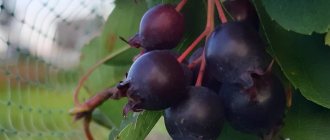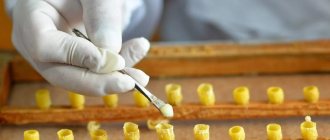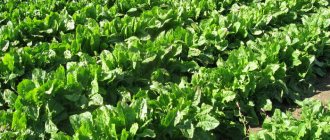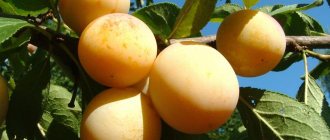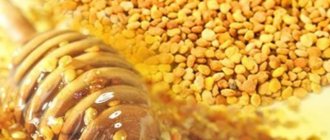History of selection
The Patriot variety is native to North America. Obtained in 1952 as a result of crossing Earliblue, Dixi and Michigan LB-1. This is how a new variety of tall blueberry, Patriot, was formed. Its name was given in connection with the 200th anniversary of the union of the states.
Its seeds became available only 24 years later. The Patriot blueberry variety immediately received approval due to its decorative properties and high yields. The variety was brought to our country in the 90s of the 20th century. As of today, it is not yet in the state register.
Blueberry Patriot - photo
Botanical description
Blueberry Patriot is a variety of mid-early maturity. The berries ripen around mid-July. Depending on climatic conditions, growing times may vary slightly. North America is considered the birthplace of blueberries. The Patriot variety was developed in Maryland in 1952. However, seedlings went on sale only in 1976.
The bushes of the plant are tall. They reach 1.6 m and even 2 meters in height. The shoots on the bush are erect and moderately branched. The shrub is covered with small leathery leaves of a juicy green color. Young leaves have a reddish tint.
As they grow they become dark green. All these qualities make Patriot bushes very attractive to look at. In addition to the high yield of berries, many gardeners note the high decorative qualities of this variety. In spring, the plant will pleasantly delight you with its flowering, and in autumn it will surprise you with the rich color of its foliage.
The Patriot variety is distinguished by its powerful growth force. Its large berries reach 19 cm in diameter and resemble beautiful balls in appearance. These berries are considered the most delicious and largest among blueberry varieties. The period from flowering to harvest is 45-57 days. Unripe fruits are reddish in color, while ripe berries are light blue in color. The fruits on the bushes are collected in clusters.
Patriot fruits taste pleasant and have a flattened shape. Fresh berries taste very good
The peel is elastic, which is important for transportation and long-term storage.
Blueberry Patriot: variety description
The bush has an elongated, oblong shape. The height of an adult Patriot blueberry plant ranges from 1.5 -1.8 meters, it is considered tall. The shoots are straight, not very dense. Branching is average. The leaves are also elongated, reaching a length of 8 cm and a width of 4 cm. Young leaves have a reddish tint, while mature leaves are rich, dark green. The root system of this blueberry is dense and branched, going up to half a meter deep.
Patriot inflorescences are white, bell-shaped. Formed into clusters that simply hang from the branches.
The berries are collected in lush clusters. In an immature state they are red in color; as they mature, the color changes from light blue to a more saturated one with a bluish tinge. The size of an individual Patriot blueberry is from 15 to 20 mm. The shape is slightly flattened. The berries are covered with a smooth, even, elastic skin. The berries taste sweet and have a pleasant berry aroma.
Photo of blueberries Patriot
How to grow blueberries
The requirements for growing conditions and care of blueberries differ from the usual currants, gooseberries and raspberries. In particular, organic matter in the form of humus, chicken droppings and manure is contraindicated for Patriot; it needs acidic (pH 3.5–4.5), moist and loose soil. Failure to comply with one of these rules will lead to the death of the plant. Patriot has a huge advantage: resistance to diseases and pests. As gardeners say, he is not sick with anything. Almost all the misfortunes characteristic of other fruit crops bypass blueberries.
Dates, place and stages of planting
The best periods for planting are spring, before buds open, and autumn, after leaf fall. In northern regions with a short autumn, it is better to choose spring. The place for blueberries should be well lit and warmed by the sun, while it is desirable to have protection from the wind on the north side in the form of a wall, a solid fence or a hedge.
The best predecessors are perennial herbs. Blueberries cannot be planted after crops that have been supplemented with organic matter, ash, lime, dolomite and bone meal.
The planting hole for blueberries is filled with a special mixture that has nothing in common with ordinary soil on the site
Planting stages:
- Dig a hole 40–50 cm deep and 70–80 cm in diameter, or even better, 1 m. The fact is that blueberry roots are superficial and spread out. The wider the planting hole, the longer the blueberry will have enough soil suitable for it. If the hole is small, the roots will quickly reach ordinary soil, the plant will develop chlorosis, stop growing, and the yield will decrease. You will not need the removed soil; you can immediately distribute it evenly throughout the area.
- Spread a strong film, tarpaulin or other material on the ground on which you can shovel the substrate to fill the hole. Pour high-moor (acidic) peat, river sand, rotted sawdust from coniferous trees onto the prepared surface and mix.
You can limit yourself to peat and sawdust or peat and sand in equal proportions.
- Fill the hole with the resulting mixture. You can’t compact it too hard; blueberries love lush soil. Do not be afraid that after planting the soil will sag without compaction; the situation can be easily corrected by adding peat or sawdust. Young blueberries can be buried up to 10 cm, and mature blueberries can be planted up to 30 cm in height.
- Before planting, soak the roots of the seedling in water for an hour.
- If the blueberry bush was grown in a container before transplanting, then lower the container into water, and after soaking, carefully free the root system from the container and examine it. It often happens that the roots penetrate the entire lump, reach the bottom, bend and grow inside. In this case, untangle and straighten the roots.
- Make a hole in the center of the planting hole the size of the seedling's root system. In this case, the roots need to be positioned horizontally, pointing in different directions. Planting depth is 2–3 cm below the previous level.
- Pour in acidified water (100 ml of 9% table vinegar per 10 liters of water).
- Mulch with peat, sawdust, pine needles or a mixture of these materials. Mulch height is 7–10 cm.
Video: rules for planting blueberries
Watering
If the groundwater in your area runs deeper than 40–60 cm from the surface, then you will have to water the blueberries often - twice a week, 2 buckets per fruit-bearing bush. It is recommended to divide this dose in half: one bucket in the morning, one in the evening. Gardeners who cannot visit their plots as often use drip irrigation. On especially hot days, blueberries can be watered over the leaves.
The rate of watering blueberries depends on weather conditions, the size of the planting hole and the absorbency of the soil.
However, do not blindly follow the instructions. The rate of watering depends on weather conditions, the size of the planting hole and the absorbency of the soil around it. Watering should be done using a watering can with a strainer so as not to wash away the light soil. Once a week, acidify the water, as when planting, with table vinegar or citric acid (1.5 tbsp per 10 liters of water). Monitor the intensity of water absorption; it should go deep and not stagnate at the top. After watering, squeeze a ball of blueberry soil in your fist. If drops of water are squeezed out, it means the bush is over-waterlogged. Add mulch underneath and reduce the amount of water next time. Remember that overwatering the roots is just as dangerous as drying them out.
Some gardeners limit the planting hole by constructing wells with waterproof walls (for example, planting plants in cut and dug barrels). This is done in order to protect the blueberry roots from ordinary soil with inappropriate acidity. As a result, with heavy rains and watering, water stagnates, excess moisture has nowhere to go, roots rot, and plants die.
Features of soil content under blueberries
The soil under blueberries is different from the rest on your site, and therefore requires different care:
- As the bush grows, expand the planting hole by digging a groove adjacent to it around the circumference and adding acidic soil. In this case, the roots cannot be damaged, which means that digging must be done in advance, ahead of the growth of blueberries. An adult Patriot bush occupies a plot of land with a diameter of about 1.5 m, and its root system is the same size;
- near the bush you cannot cut down weeds with a hoe and loosen the soil deeper than 3 cm. The roots of blueberries are superficial and practically do not recover;
- Regularly, as the ground subsides, add mulch, you can bush up the bushes. Use peat, rotted sawdust, and pine litter. These materials acidify the soil, and their thick layer prevents the rapid evaporation of moisture and inhibits the growth of weeds.
Video: how and with what to mulch blueberries
Feeding
Fertilizers for Patriot blueberries should also be acidic. It is recommended to apply nitrogen-containing fertilizers three times per season with an interval of 2 weeks, starting in early spring and ending on July 1.
Fertilizer compositions:
Recent Entries
5 working ways to use tar in the garden 7 indoor plants that help you get married even in adulthood Indoor plants that can bloom in trouble
- mulch from rotted bark of coniferous trees;
- infusion of herbs containing acid (rhubarb, sorrel, sorrel, chop, add water, leave for 1-2 days and pour under a bush);
- Ammonium sulfate: 1 tsp. for 10 liters of water.
The dose of liquid fertilizer depends on the moisture capacity of the soil - 5–10 liters per adult plant. In the second half of summer, add 100 g of superphosphate, 15 g of magnesium sulfate, 2 g of potassium sulfate and zinc sulfate per bush (dissolve in 10 liters of water or scatter on the ground, water and mulch).
For feeding, a ready-made mixture for blueberries or heather crops, for example, azaleas, is also suitable.
The easiest way to fertilize is to buy a special fertilizer and follow the instructions.
Formation and pruning of the bush
Patriot is prone to thickening because it is characterized by intensive shoot growth. You need to start pruning after 3–4 years, removing crooked, broken, weak, frozen branches growing inside the bush. The goal is to form a plant from the strongest shoots, equidistant, directed in different directions, and not interfering with each other’s growth.
When pruning, you need to remove crooked, broken, weak, frozen branches growing inside the bush
After another 2 years, pruning becomes more complicated by removing all the old 5-6 year old shoots. After 10–15 years of life in your garden, the yield of Patriot will decrease, the berries will be crushed. To restore previous productivity, it is recommended to cut off the entire bush near the ground, leaving only the roots. Such rejuvenating pruning will provoke the active growth of new shoots. In just 2–3 years, blueberries will again delight you with an abundance of large fruits. As a result of such care, the Patriot is able to live for more than a century.
Carry out all activities related to the formation of the bush in early spring, before the sap begins to flow.
Video: pruning blueberries
Shelter for the winter
Despite the declared frost resistance of the variety, in severe and light winters the upper parts of the shoots can freeze to the level of snow. In addition, Patriot is tall, and a snow cover thickness of 1.5–1.8 m is very rare for many Russian regions. For these reasons, either cover blueberries for the winter, or be prepared to radically shorten all frozen shoots in the spring.
Before the onset of cold weather, cover the ground and lower part of the bush with spruce branches; it will protect the roots from freezing, and the shoots from being eaten by mice and hares. Wrap young low bushes entirely with breathable covering material. Bend branches over 1 m high to the ground and also insulate them with breathable materials.
Young blueberry bushes can be wrapped entirely for the winter
Characteristics of the variety
Patriot is a variety with a medium ripening period. It is grown for industrial production. From one Patriot blueberry bush you can collect from 6 to 9 kg of ripe berries. The fruits can be collected mechanically without fear of damaging the berries, since their peel is dense and strong.
The ripening period for Patriot blueberries is the second half of July.
. But, of course, when determining the ripening period of berries, it is important to take into account the climatic conditions of the region where the Patriot blueberry variety is grown.
The culture has fairly good storage and shelf life. Without any difficulties, it can be stored for 14 days, maintaining a fresh, just-picked appearance.
Frost-resistant blueberry variety Patriot
. Able to survive cold temperatures from -30 to -35 degrees. This makes it popular for cultivation in the northern regions.
Blueberry Bluecrop - video
For this variety, the composition of the soil is very important. Prefers predominantly acidic soils.
The most suitable acidity levels are between 3.7 and 4.9pH. When this indicator gets closer to 5.5, it can negatively affect the entire crop, reducing its performance. When the acidity level is even higher (for example, reaches 6.5), growth stops.
Low acidity is also unhelpful. In this case, the protective properties decrease, and the plant is exposed to diseases and pathogens.
Characteristic
Characteristics of the Patriot blueberry variety, like most other fruit crops, include the plant’s resistance to low temperatures, lack of moisture, diseases and pests, as well as the timing of flowering and fruit ripening.
Main advantages
Patriot blueberries are varieties that are highly resistant to low temperatures and moderate drought. According to numerous data, the shrub is able to withstand frosts down to -30 - 35 ° C and short periods without precipitation.
The berries demonstrate high keeping quality and transportability. The fruits retain their original appearance and do not lose their taste for 10-14 days, subject to all storage standards.
Very often, blueberry varieties are compared with each other. But, for example, it is impossible to say which blueberry is better: Patriot or Bluecrop. Both of these varieties are similar to each other, the only difference is the greater height of the bush and higher yields of the Bluecrop variety.
Flowering period and ripening time
Blueberry flowering is a rather long process, starting in mid-May and ending in early July. Accordingly, blueberry fruits begin to ripen in mid-July.
Despite the fact that this variety is a self-pollinating crop, it is still recommended to plant other shrubs nearby for pollination. This will increase the yield of the plant several times. Pollinators for Patriot blueberries should be selected so that the flowering periods of the varieties coincide.
Yield indicators, fruiting dates
One of the main advantages of the shrub is its high yield; reviews of Patriot blueberries are clear confirmation of this. From one bush you can collect up to 8-9 kg of berries.
Important! It is undesirable for all blueberry varieties to bear fruit in the first year after planting. Therefore, during the flowering period, it is recommended to pick off all flowers to prevent the formation of berries.
Area of application of berries
Patriot highbush blueberries are used in different forms. Berries can be eaten fresh, frozen, canned, used to make preserves, jams, syrups, and so on.
Resistance to diseases and pests
Patriot blueberries are characterized by strong immunity to diseases and pests, especially late blight and root rot. However, it is still recommended to occasionally treat shrubs to prevent diseases.
Advantages and disadvantages of the variety
Summarizing all of the above, the main advantages include:
- high drought and frost resistance;
- safety of berries during transportation;
- high keeping quality;
- immunity to many diseases;
- high productivity;
- taste qualities of fruits;
- decorativeness of the bush.
The Patriot variety has only two drawbacks:
- demands on soils;
- fruit shrinkage towards the end of the fruiting period.
That is why Patriot is one of the best varieties of berry crops, which is why it has become widespread throughout the world.
Productivity of blueberry variety Patriot
The final formation of berries occurs in the 2nd half of July. The berries must be picked immediately, because 10 days after ripening they begin to deteriorate. Productivity increases gradually. So, in the first years of growing the crop, the level of yield indicators of the Patriot blueberry variety is only from 2 to 3 kg, in subsequent years from 7 to 9 kg.
Harvesting: how to store, what to prepare
Patriot blueberries begin to be harvested in mid-July. The berries ripen unevenly, so they are picked in several steps. The first fruits are large, but by the end of the harvest they become very small. The thick skin makes storage and transportation possible. In the refrigerator, in an airtight container, blueberries remain fresh for 2 weeks, and when frozen they retain their taste and aroma for a whole year. It is better to eat the first large and beautiful berries fresh, while small ones should be processed.
Blueberries are rich in antioxidants that slow down cell oxidation and aging. In addition, this berry contains substances that can lower blood sugar levels, break down fat, and strengthen the walls of blood vessels.
Blueberries are used to prepare compotes, preserves, jams, and candied fruits, and are used as a filling and decoration for baked goods. Very aromatic and beautiful tinctures, liqueurs and liqueurs are obtained from this berry. On winter evenings, tea made from dried blueberries with honey will warm you up and remind you of summer.
Video: American blueberry juice
Blueberry Patriot: planting and care
The Patriot variety begins to flower at the end of May. The duration of flowering ranges from 45 to 55 days. For this reason, Patriot is considered an ornamental crop. The shrub blooms the next year after planting. Flowering reaches its highest rates in the 5th – 6th year after planting in a permanent place of growth.
Attention!
In the year the plant is planted, it is worth stopping the formation of berries, for which experienced gardeners recommend picking off the inflorescences.
How to plant Patriot blueberries
So, planting Patriot blueberries can take place in two periods
:
- from April to May;
- from September to October.
Before planting a crop, choose the right place and prepare the soil.
Blueberries require plenty of sunlight. The place must be protected from the wind. Plain soil is not suitable for growing this variety. You need to make it yourself by mixing peat, soil, sand. Since acidity is important, it is worth checking its level in the soil in advance and making appropriate adjustments. Blueberry variety!
Blueberry Bluecrop
When choosing seedlings for planting, be sure to pay attention to their condition: they must be undamaged and intact. The development of the roots is also important, as is the healthy state of the foliage and shoots.
Algorithm and scheme for planting Patriot blueberries
:
- Prepare a planting hole up to half a meter deep and 70 to 100 cm wide.
- Make a substrate by mixing sand, peat, and pine sawdust.
- Installation is carried out in the center of the pit.
- A blueberry seedling is tied to a stake, carefully straightening the roots.
- The substrate is brought into the hole and compacted.
- Add a sufficient amount of water, mulch with spruce needles and tree bark reaching a height of 7 to 10 cm.
How to plant blueberries correctly - video
To water Patriot blueberry seedlings, use slightly acidified water.
. For a bucket of water, 1/2 cup of 9 percent vinegar is enough. For clay soil, the hole should be deeper, from 70 to 80 cm. The bottom is lined with drainage, the thickness of which is approximately 20 cm. This will help prevent moisture stagnation.
Aftercare for Patriot blueberry crop
Further care for blueberries involves systematic watering, fertilizing and pruning bushes.
.
How to water blueberries correctly
Watering is carried out at least twice every 7 days
. One bush requires up to 10 liters of water. This volume is divided equally. One part is used for morning watering, the second part for evening watering. To retain and evenly distribute moisture in the soil, the soil is loosened and mulched. For mulching, pine sawdust, peat or gravel are used.
To acidify the soil, water with slightly acidic water once every 7 days.
To prepare it use:
- table vinegar at the rate of 100 ml per bucket of water;
- oxalic, citric acid (5 g per bucket of water);
- battery electrolyte (30 ml).
When growth slows down, it is worth watering the soil more often with acidified water
, checking the acidity level of the soil from time to time.
Rules for fertilizing Patriot blueberries
Fertilizer is carried out three times a season.
Stages of feeding Patriot blueberries during the season:
- Fertilize blueberries for the first time in the spring before the juice begins to flow;
- the second - at the end of May;
- the third - in the second half of July.
Blueberry Patriot feels great in the conditions of the Urals, Siberia, and the Far East.
Rules for feeding blueberries - video
Blueberry Patriot - bush pruning
For better fruiting, the bushes are systematically pruned
. Pruning is carried out from the age of 6 years (after planting in a permanent place of growth).
Patriot blueberries are pruned as follows:
:
- remove empty branches at the bottom of the plant;
- branches whose age exceeds 6 years.
Blueberries - details of pruning
The time for pruning is spring, when sap flow in the plants has not yet begun.
. Reaching 15 years of age, blueberry yields decrease. In this case, it is worth cutting the bush right at the root. After a couple of years, the young shoots will begin to bear fruit again.
Landing rules
Planting and caring for Patriot blueberries does not cause any difficulties at all. The main thing is to take into account the requirements of the plant and try to maintain optimal environmental conditions.
Recommended timing
Planting Patriot blueberries in the spring will allow you to avoid the death of a young seedling due to severe frosts. However, for southern regions with warm winters, autumn is also suitable for planting blueberries.
Choosing a suitable location
The place for the bush should be illuminated, but at the same time protected from strong and gusty winds. Patriot blueberries should be planted in acidic soils, preferably loamy or sandy loam.
Soil preparation
About 7-9 days before the planned planting of the seedling, you need to dig a hole with a diameter and width of 60-65 cm and mix the soil with sand, crushed bark or sawdust. If the soil is alkaline, additional mineral fertilizers should be added to increase the acidity of the soil.
Selection and preparation of seedlings
Reading reviews about Patriot garden blueberries, you can often come across information that the right choice of seedling is the key to successful growth and development of the shrub. Therefore, when purchasing planting material, you should pay attention to the integrity of the root system and shoots, as well as the absence of any signs of disease.
Algorithm and landing scheme
Planting Patriot blueberries is carried out in several stages:
- Digging a hole and preparing the substrate.
- Installing a stake in the center of the pit.
- Planting a seedling, straightening the root system and tying the trunk to a stake.
- Backfilling and compacting the earth.
- Watering the soil and mulching with bark or pine needles.
Advice! When planting several seedlings at the same time, it is important to maintain a distance of at least 1 meter between them.
Preparing blueberries for winter
The process of preparing for wintering varies depending on the climatic conditions of each area
. Typically, phosphorus and potassium fertilizers are added to the soil in the fall. Be sure to mulch the soil. The thickness of the layer ranges from 10 to 12 cm.
For better wintering in the conditions of the Moscow region and the Volga region, Patriot blueberry plants are wrapped in material that allows air to pass through well
.
Before this, the shoots of adult plants are fixed on the ground. Young shoots are wrapped together with the plant. It is recommended to use spruce branches for the lower part of the bush and roots. In the conditions of Siberia and the Urals, there is no need to wrap up, since snow is the best natural material for this purpose
.
Caring for blueberries in the fall and preparing for winter
Subsequent care of the crop
As mentioned earlier, even novice gardeners can grow and care for Patriot blueberries. It is only important to follow the regime of watering and feeding the bush, as well as timely formation of the crown and preparation of the plant for the coming winter.
Necessary activities
Watering is carried out twice a week with 10 liters of water (5 liters in the morning and 5 liters in the evening). You can also install a drip irrigation system. It is always worth focusing on weather conditions and the degree of soil moisture.
Fertilizing Patriot blueberries is carried out three times in one season with an interval of 12-14 days. The first application of fertilizers occurs in early spring, and the last in early July. The optimal fertilizers are nitrogen-containing components.
Shrub pruning
This variety is characterized by a tendency to thicken the crown, therefore, starting from the 4th year of the bush’s life, it is necessary to regularly prune the plant. After the procedure, the strongest shoots should remain that do not interfere with each other.
The photo of the Patriot blueberry bush shows one of the options for forming a bush.
Preparing for winter
Planting and caring for Patriot garden blueberries also includes activities aimed at preparing the plant for the onset of cold weather. It is recommended to cover the lower part of the bush and the ground with spruce branches. This will prevent the shoots from freezing and being damaged by rodents.
Applications of blueberries
The scope of application of blueberries is quite wide. It is eaten both fresh and processed. So, delicious jams, fresh juices, juices and pastes are made from it. Syrups deserve special attention. They are not only tasty, but also healthy for children and adults.
The berries are dried and frozen fresh. So they can be stored for a long time, retaining useful substances and minerals in their composition. Blueberries are great for baking.
Collection and storage of blueberries
A fairly dense skin allows the berries to be well preserved during transportation, and also not to deteriorate for a long time during storage. Freshly picked blueberries at a temperature of +2...+4°C in a closed, airtight container remain fresh for 2 weeks. Berries are also often frozen: in this form they retain their taste, aroma and beneficial properties for almost a whole year.
At the end of the season, small, but equally tasty berries ripen - you can use them to make compotes, preserves, jams, and even make candied fruits. Many housewives prepare tinctures and liqueurs from these berries, and they can also be dried.
Advantages and disadvantages
Patriot has advantages and disadvantages, like every culture.
Advantages:
- high level of productivity;
- ability to withstand and adapt to drought;
- high immunity;
- decorativeness;
- Patriot blueberries have excellent taste characteristics;
- many uses in cooking;
- the ability of fruits to be stored for a long period of time.
Flaws:
- cultivation requires careful soil preparation;
- at the second stage of fruit formation, their size becomes smaller.
The advantages significantly outweigh the disadvantages, and therefore many vegetable growers grow the Patriot blueberry variety on their plots.
Pros and cons of the variety
After familiarizing yourself with the characteristics of Patriot blueberries, its advantages are obvious. The main advantages of the variety include:
- high yield (up to 8-9 kg per bush);
- decorative qualities;
- strong immunity;
- excellent taste of fruits;
- resistance to frost and drought;
- good transportability;
- long shelf life of berries.
Among the disadvantages, it should be noted that it is demanding on soil characteristics, however, this is a feature of all garden blueberries. The soil for this crop must be loose, nutritious and acidic. In addition, some consider it a disadvantage that towards the end of fruiting the berries become smaller in size. The application of fertilizing to maintain the strength of the plant during the formation of berries will help to correct the situation somewhat.
Control of blueberry diseases and pests
The variety is susceptible to diseases. High humidity can provoke them. As a preventive measure, it is worth replacing the mulch in full once every couple of years and carrying out preventive maintenance. They use Bordeaux mixture, which is sprayed with it 2 times a year: at the very beginning of spring and in the second half of autumn.
How to deal with blueberry pests - video
Blueberries have pests, including: silkworms, scale insects, cockchafers, aphids, and leaf rollers. To eliminate them, insecticides and fungicides are used.
Interesting!
Gooseberry Commander
Blueberry Patriot is an excellent variety that can be grown in any climatic conditions
. It bears fruit in both the northern and southern regions of the country. In addition to high yields, it has good taste characteristics. Decorates the garden plot, performing a decorative function.
Diseases and pests, methods of control and prevention
Proper care of Patriot blueberries will help avoid disease of the bush and damage by pests. The main methods of control and prevention are presented in the tables.
| Disease | Ways to fight |
| Gray rot | Treating the plant with Bordeaux mixture. Burning affected leaves. |
| White spot | Regular mulching of the soil, spraying the bushes with complex preparations. |
| Pest | Method of prevention and control |
| Birds | Installing a mesh around the bush |
| Aphid | Treatment with insecticides. |
Blueberry Patriot: reviews from those who planted and cultivated the variety
Reviews of the Patriot blueberry variety can be read below.
Vera Sergeevna, 59 years old, Ryazan I really love blueberries. I searched for a suitable variety for a long time and found Patriot. I chose it because of the positive reviews. I liked that the plant can grow in any climate, which means it is resilient and strong. I had to tinker with the soil. In principle, there is nothing complicated. The yield was average, 3 kg per bush.
Ivan Mikhailovich, 47 years old, Zelenograd The Patriot variety showed excellent results in the first year after planting. Gave a good harvest. In our climatic conditions, growing it is not particularly difficult. The crop was not sick, and no pests were observed either. The berries are very tasty and juicy. I recommend.
Description
The highbush blueberry variety "Patriot" was developed in 1976 in the USA. It was created for landscaping areas. The main function of the plant was decorative; later it was also grown to harvest delicious berries.
Bush
The blueberry bush reaches an average height of 1 m. Its distinctive feature is its high decorative qualities.
Did you know? Blueberries can bear fruit for 100 years, but only with proper care.
Green plantings ripen in July - in the middle of the month or in the second half. It turns out that between the flowering of the shoots and the ripening of the harvest, a little more than a month passes - about 40 days.
One blueberry bush produces an average of 6 kg of fruit per garden season. Mature plants that have been on the site for more than 4 years can produce 9 kg of net harvest.
The leaves of the plant are small in size and have a soft oval shape. Young leaves are reddish in color; by the way, unripe blueberry fruits have the same color. Over time, while blueberries grow, the leaves gradually change color to our usual green.
The bush is defined as self-pollinating. However, gardening experts say that cross-pollination with nearby plants makes the harvest much more abundant and of higher quality.
The plant is resistant to various diseases, including root rot, a common disease in plants.
You will probably be interested in reading about such blueberry varieties as “Bluecrop”, “Divnaya”, “Northland”.
Berry
The berries look slightly flattened on the sides. The fruits are large in size, reaching 20 mm in diameter. The berries grow in clusters, and there are a large number of them on one bush.
The first harvest is the most successful - the berries are the largest during this period. That is why they are very easy to assemble by hand. Further harvesting involves smaller berries, which are difficult to pick. Therefore, a mechanized harvesting method is used for such a crop.
The fruits have a characteristic bluish color. Berries that are not fully ripe will have a reddish tint. The stalk is small and may not be immediately noticeable. The color is characteristic green.
Breeding the variety
There are 3 main methods of propagating Patriot blueberries:
- by seeds - a long and labor-intensive process, usually used to obtain new varieties;
- cuttings are the most convenient option; they can be harvested in the fall;
- layering - produces a small amount of planting material, but there are no difficulties in rooting the resulting bushes.
For inexperienced gardeners, it is better to propagate Patriot blueberries by cuttings .
Landing area
The variety has its own characteristics and you should immediately choose a specific place on the site. A sunny and windless location is best. Acidic soil is suitable for growing. You can use several components for this:
The desired level of composition can be obtained by adding a little sulfur to the soil mixture. Before planting blueberries, it is necessary to prepare such soil on the site 7-10 days in advance. Bushes are usually planted in early spring or late autumn.
Young bushes are planted in prepared holes measuring 80x80 cm. First, drainage and prepared acidic soil should be placed at the bottom of the hole. Since the root system of young plants is poorly developed, it is lowered to a depth of 10-15 cm. The earth should cover the trunk of the bush with a layer of 4-6 cm. The roots must be straightened so that a lump does not form.
After planting, be sure to mulch the area around the trunk. To do this, use dry coniferous bark or old needles from coniferous plants. The distance between bushes should be up to one and a half meters. If you plant them too densely, then you will have to apply more fertilizer.
History of the variety's creation
This variety was bred in the mid-seventies of the last century, but only in 1997 was it put into production. Like many other varieties, Patriot has American roots, because the ancestor of any modern garden blueberry variety is wild blueberry, which grows naturally in swampy areas and deep forests of North America.
Most of the current cultivated varieties were created by American breeders, including this one - it was bred by breeders from the USA: P. Hepler and A. Draper. The cultivation of this variety is especially indicated for central Russia, where autumn and spring can be characterized by frosts, and thaws occur in winter. This variety can withstand frosts down to minus 30 degrees.
Often, even in specialized literature, blueberries are called blueberries, which, in fact, is correct, because Patriot, like other varieties of blueberries, is a cultivated wild blueberry. Thanks to the efforts of breeders, the characteristics of the cultivated berry have improved significantly - blueberries are sweeter, denser, and their flesh is white and does not stain hands at all, like blueberries.
Other varieties
In addition to the previously mentioned blueberry varieties, it is simply impossible not to remember such varieties of plants as: River, Puru, Bluejay, e1 blueberry, Coville, Nenets fairy tale, blue Placer, Ivanhoe, Herbert variety, Pink Lemonade, Pink blueberry, Blue Giant, Draper , Boniface, Aurora, Blue Swade, Big Blue, really, Herbert, Stanley, Puru, hard blue, giant blue, blue diamond, Miller, Sans Yandera, Hannah Choice, American highbush, highbush Goldtraube, Sweet Grape, Puru, Giant blueberry, Brigitte, Goldtraube, Chandler, Blau Pearl, Sadovaya Mider, Tophat, Erliblue, Herbert, Sierra, Chentekl, Lesnaya, Aino, Concord, Atlantis.
If desired, every gardener can plant such a plant on their territory and annually enjoy the tasty, large and, most importantly, healthy fruits of the bush.
Rules for growing the variety
Timely watering and high-quality fertilization are the conditions for caring for the variety.
You need to water abundantly, but not often, mulching the ground under the bush and retaining moisture. Many gardeners recommend acidifying the water when watering, because blueberries love acidic soil. But in order to know exactly how many grams of acid (citric, acetic or electrolyte) should be taken per bucket of water, it is better to measure the pH level in a given area once with a professional device and find out the proportion of acid and water required to achieve the desired acidity level. Normal “blueberry” acidity of water and soil is pH 3.5-4.5 units.
For fertilizer, you do not need to use organic matter: manure or chicken droppings. It is better to take mineral fertilizers. There are ready-made fertilizers on sale based on ammonium sulfates, the basic nitrogen fertilizer for this plant. Fertilizers can be applied from April to June, but not later. Potassium fertilizer is useful for adding sweetness to the berries. It is good to add potassium phosphate in October - this will help the blueberries not to freeze in winter.
The bush is pruned at the age of 5 years; at this time it should be slightly thinned out. Pruning is done either late in the fall, after the loss of foliage, or in early spring, when the buds have not yet opened.
Rules for growing berries
The Patriot blueberry species prefers garden, sandy soil and loam. The bush grows best in acidic, aerated soil, easily warmed by sunlight and containing at least 3% humus. Groundwater should not rise to 70 centimeters. It is advisable to take care in advance about the drainage of excess moisture from the bush.
The acidity of the soil should be 4.2-4.5 pH. A higher level entails an increased risk of fungal infection. The bush's metabolic processes deteriorate, nitrogen digestibility decreases, and susceptibility to chlorosis increases. If the acidity of the soil decreases to pH 6, Patriot blueberries die.
When to plant?
The best period for planting seedlings is spring, until mid-April, or autumn, in mid-October. In northern latitudes, it is advisable to give preference to spring planting. Autumn planting allows you to adapt to winter and new conditions; in the spring, more active growth of the bush is observed. Patriot blueberry seedlings with a closed rhizome can be planted in open soil throughout the season.
Selection of seedlings
Planting material for Patriot blueberries should be purchased from trusted sellers, at the market or in a special store. It is necessary to choose the right seedlings:
- do not buy seedlings with bare roots, they dry out quickly;
- inspect the appearance, the seedling should be undamaged, rich green in color.
If the seedlings selected are of poor quality and stale, the bush may not take root.
Dates, place and stages of planting
Blueberry Patriot prefers places where the sun constantly shines and there are rarely drafts and winds. It is better to plant it next to a fence or outbuildings, they protect from windy gusts. If the bush grows in partial shade, the yield decreases, the berries become smaller, and their taste is less sweet. It is better to grow berries in elevated areas and dig trenches in advance to drain the liquid. If we are talking about predecessors, they should be perennial grasses. The plant should not be planted after crops fertilized with organic matter.
Stages of planting Patriot blueberries.
- Dig a hole 45 centimeters deep and 1 meter in diameter.
- Spread a strong film or tarpaulin on the ground, mix the substrate for filling. Pour high-moor peat, river sand, and rotted pine needles onto the prepared surface and stir.
- Fill the hole with the prepared mixture, without compacting it too much. Young bushes should be deepened to 10 centimeters.
- Before planting, immerse the root system in water for 1 hour.
- Straighten the roots, make a hole in the center of the hole corresponding to their size. Place them horizontally. The planting depth is 2-3 centimeters lower than the previous level.
- Pour acidified water - 100 ml of 9% table vinegar per 10 liters of water.
Mulch with peat, dust, pine needles and a mixture of these components. The height of the shelter should be 10 centimeters.
Tips and tricks for planting
The Blueberry variety “Patriot” is somewhat different from others in planting and caring for it. The soil for planting must be prepared immediately. It is advisable that the plant be located in a well-lit area, as it loves the sun and grows better in bright exposure.
Selection of seedlings
In order for the harvest to be good, you must initially find the right seedling. You should not buy shoots that have just been planted in a container. Make sure roots are visible in the holes.
The color of the bark should be dark at the base of the plant and lighter towards the top. If you find that the leaves have a yellow tint, this means that the plant is receiving an excess of potassium or calcium.
In this case, it will be necessary to limit the supply of these elements to the roots. However, it is better to initially buy healthy seedlings.
The best place
So, we already know that it is better to plant blueberries in places that are well lit by the sun. Also make sure that drafts or strong winds do not blow into the area where the bush grows. All this can cause irreparable harm to the plant.
It is better to plant blueberries on a hill. This will ensure the drainage of excess moisture from a plant that does not like it. This effect can also be achieved by creating a trench that can be dug in a convenient place.
Soil preparation
Why do you need to prepare the soil for blueberries? The fact is that ordinary black soil is not suitable for the healthy life of Patriot blueberries. Make sure the soil is acidic before planting.
Recommended pH level: 3.2 to 5.2. If the balance exceeds the maximum level, it can be reduced by adding sulfur (but this must be done in the previous season). This way the soil will be oxidized by soil bacteria.
It is better if blueberries grow in loam or sandy loam. This soil composition is optimal; the plant will not accept a heavier soil.
It is necessary to create the most comfortable conditions for the growth of the bush, namely to prepare well-drained soil. It can be made from peat and sand. Soil is also added, which it is advisable to take from under the pine tree.
The plant grows well in soil that contains a lot of organic matter. Therefore, experts often recommend planting green manure crops in the area where blueberries will be grown next year.
You need to plant the plant early, but when exactly - in spring or autumn - depends on you. If you live in an area that has a cold or cool climate, it is best to plant in the spring.
The soil should already be quite acidic by the time of planting. To do this, you can add sulfur to the soil for plowing six months in advance (no later), or simply water the soil with acidic water.
Seedlings for planting should already be in containers near you. Remove them from there and straighten the roots. Be careful: do not tear or confuse the roots.
The holes in which blueberries should be planted should be 60 cm deep, 80 cm wide and high. You can make the size wider (but not deeper) if the area of the site allows. Keep a distance of 2 m between rows. It is recommended to sprinkle pine needles on the ground after planting for better nutrition and moisture saturation.
Features of care
The main rule in caring for any plant is timeliness. The same is the case with blueberries: do not forget to water them on time so that the soil does not dry out.
Scattering pine needles over the roots also helps preserve the surrounding soil from pests such as weeds that interfere with the normal growth of blueberries. And you can increase the level of productivity using a simple technique: 5 years after the first flowering, prune the bush.
Read also: Ficus benjamina - care at home
The plant must be properly irrigated. Most often, a drip system is used for this. This is very convenient because, if necessary, it can be used to add pest protection products to the soil.
This method also protects against frost, which can suddenly overtake blueberries in the spring, and is excellent for watering in the summer. The disadvantages of drip irrigation are high water consumption and loss of ideal appearance.
It is better to prune plants in early spring. In this case, you can see which parts of the shoots have deteriorated after wintering and remove them. Remove thickened stems as well. Their presence will interfere with the normal development of the berries, and as a result the fruits may grow too small.
Description and characteristics
The most common blueberries in dachas today, planted and cared for in the Moscow region, are Patriot and Bluecrop. The last variety is good because it is not afraid of either pests or snow, which is important in the conditions of the Moscow region. However, many believe that the taller, also winter-hardy and earlier fruiting Patriot blueberry is preferable; we provide a description of this variety in more detail.
Blueberry variety Patriot grows well in any soil, but loves moist soil. Another feature of the variety is that it has green or red berries almost the entire season. As such, Patriot blueberries (also called blueberries because of the dark blue color of the berries) become blackish only at the very end of ripening. Fully ripened berries have a deep dark color, which is hidden under the whitish coating characteristic of this berry. It is this coating that gives it a true blueberry hue.
Patriot blueberries ripen quite early; already in mid-July you can enjoy a delicious berry, sweet, pleasant, with a slight sourness. The berries are quite large - up to 1.9 mm in diameter, juicy, dense.
The variety is easy to care for and harvest because it has an average height of 1.2 to 1.8 meters.
The largest catches are from the first collection, then they become a little smaller. The berries grow in weighty inflorescences, have a slightly flattened appearance, they have a medium-sized perianth, and the berries come off easily and dryly.
If you do not thin out the shoots, the variety, which is itself highly productive and prone to overload with the harvest, can produce a lot of crushed berries. In general, with good care, up to 9-10 kilograms of ripe berries are harvested from a bush.
It’s good if there are bushes of a different variety on the site. Another variety will act as a natural pollinator, and such cross-pollination will give a much larger and more stable harvest, although in principle the Patriot variety is self-pollinating.

